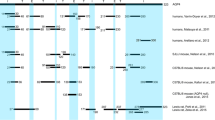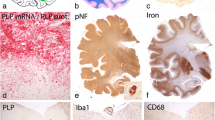Summary
To clarify the implication of the major histocompatibility complex class II (Ia) antigen induction in microglia following Wallerian degeneration in the central nervous system (CNS), experimental allergic encephalitis (EAE) was adoptively transferred to Lewis rats in which Ia antigens had been induced in microglia at the sites of Wallerian degeneration. In addition to randomly distributed typical EAE lesions, the recipient rats developed distinct inflammatory lesions in accord with the distribution of Ia-positive microglia; i.e., in the ipsilateral thalamus after cortical cryoinjury, and in the ipsilateral optic nerve, the contralateral optic tract and superior colliculus after unilateral eye ball enucleation. Thus, the EAE locus may be targeted by this approach. The inflammatory response was inducible by transfer of myelin basic protein-stimulated lymphocytes but not by transfer of phytohemagglutinin-stimulated or non-stimulated lymphocytes. When examined using monoclonal antibody surface markers; OX-6 for Ia antigen, W3/13 for pan T lymphocyte and OX-8 for cytotoxic/suppresser T lymphocyte, the types of lymphocytes in these lesions did not differ from those in ordinary EAE lesions in the spinal cord. The potential role of non-immunologically induced Ia-positive cell clusters that serve as a target for autoimmune CNS diseases was discussed.
Similar content being viewed by others
References
Akiyama H, Itagaki S, McGeer PL (1988) Major histocompatibility complex antigen expression on rat microglia following epidural kainic acid lesions. J Neurosci Res 20:147–157
Bellini T, Rippa M, Matteuzzi M, Dallocchio F (1986) A rapid method for purification of myelin basic protein. J Neurochem 46:1644–1646
Clark G, Bogdanove LH (1955) The induction of the lesions of allergic meningoencephalomyelitis in a predetermined location. J Neuropathol Exp Neurol 14:433–437
Craggs RI, Webster H de F (1985) Ia antigens in the normal rat nervous system and in lesions of experimental allergic encephalomyelitis. Acta Neuropathol (Berl) 68:263–272
Gonsette R, Andre-Balisaux G, Delmotte P (1966) La permeabilité des varissaux cerebraux. VI. Demyelination experimentale povoquee par des substances agissant sur la barriere hemato-encephalique. Acta Neurol Bel 66:247–262
Hickey WF, Kimura H (1988) Perivascular microglia cells of the CNS are bone-marrow derived and present antigen in vivo. Science 239:290–293
Hinrichs DJ, Wegmann KW, Dietsch GN (1987) Transfer of experimental allergic encephalomyelitis to bone marrow chimeras: endothelial cells are not the restricting element. J Exp Med 166:1906–1911
Jane JA, Steward O, Gennarelli T (1985) Axonal degeneration induced by experimental noninvasive minor head injury. J Neurosurg 62:96–100
Konno H, Yamamoto T, Iwasaki Y, Suzuki H, Saito T, Terunuma H (1989) Ia-expressing microglial cells in experimental allergic encephalomyelitis in rats. Acta Neuropathol 77:472–479
Konno H, Yamamoto T, Iwasaki Y, Suzuki H, Saito T, Terunuma H (1989) Wallerian degeneration induces Ia-antigen expression in the rat brain. J Neuroimmunol 25:151–159
Lassmann H, Vass K, Brunner C, Seitelberger F (1986) Characterization of inflammatory infiltrates in experimental allergic encephalomyelitis. Prog Neuropathol 6:33–62
Levine S, Hoenig E (1968) Induced localization of allergic adrenalitis and encephalomyelitis at sites of thermal injury. J Immunol 100:1310–1318
Maehlen J, Olsson T, Zachau A, Klareskog L, Kristensson K (1989) Local enhancement of major histocompatibility complex (MHC) class I and II expression and cell infiltration in experimental allergic encephalomyelitis around axotomized motor neurons. J Neuroimmunol 23:125–132
Male D, Pryce G (1989) Induction of Ia molecules on brain endothelium is related to susceptibility to experimental allergic encephalomyelitis. J Neuroimmunol 21:87–90
Matsumoto Y, Fujiwara M (1986) In situ detection of class I and II major histocompatibility complex antigens in the rat central nervous system during experimental allergic encephalomyelitis. J Neuroimmunol 12:265–277
Matsumoto Y Fujiwara M (1987) The immunopathology of adoptively transferred experimental allergic encephalomyelitis (EAE) in Lewis rats. Part 1. Immunohistochemical examination of developing lesions of EAE. J Neurol Sci 77:35–47
McGeer PL, Itagaki S, Tago H, McGeer EG (1987) Reactive microglia in patients with senile dementia of the Alzheimer type are positive for the histocompatibility glycoprotein HLA-DR. Neurosci Let 79:195–200
McGeer PL, Itagaki S, Boyes BE, McGeer EG (1988) Reactive microglia are positive for HLA-DR in the substantia nigra of Parkinson's and Alzheimer's disease brains. Neurology 38:1285–1291
Perry VH, Gordon S (1988) Macrophages and microglia in the nervous system. Trends Neurosci 11:273–277
Povlishock JT, Becker DP, Cheng CLY, Vaughans GW (1983) Axonal change in minor head injury. J Neuropathol Exp Neurol 42:225–242
Rao K, Lund RD (1989) Degeneration of optic axons induces the expression of major histocompatibility antigens. Brain Res 488:332–335
Riechert T, Hassler R, Mundinger F (1975) Pathologic-anatomical findings and cerebral localization in stereotactic treatment of extrapyramidal motor disturbances in multiple sclerosis. Confin Neurol 37:24–40
Robinson AP, White TM, Mason DW (1986) Macrophage heterogeneity in the rat as delineated by the monoclonal antibodies MRC OX-41 and MRC OX-42, the latter recognizing complement receptor type 3. Immunology 57:239–247
Sobel RA, Blanchette BW, Bhan AK, Colvi RB (1984) The immunopathology of experimental allergic encephalomyelitis, II. Endothelial cell Ia increases prior to inflammatory cell infiltration. J Immunol 132:2402–2407
Streit WJ, Graeber MB, Kreutzberg GW (1989) Peripheral nerve lesion produces increased levels of major histocompatibility complex antigens in the central nervous system. J Neuroimmunol 21:117–123
Suzuki H, Franz H, Yamamoto T, Iwasaki Y, Konno H (1988) Identification of the normal microglial population in human and rodent nervous tissue using lectin-histochemistry. Neuropathol Appl Neurobiol 14:221–227
Suzuki M, Iwasaki Y, Yamamoto T, Konno H, Kudo H (1988) Sequela of the osmotic blood-brain barrier opening in rats. J Neurosurg 69:421–428
Traugott U, Scheinberg LC, Raine CS (1985) On the presence of Ia-positive endothelial cells and astrocytes in multiple sclerosis lesions and its relevance to antigen presentation. J Neuroimmunol 8:1–14
Vass K, Lassmann H, Wekerle H, Wisniewski HM (1986) The distribution of Ia antigen in the lesions of rat acute exprimental allergic encephalomyelitis. Acta Neuropathol (Berl) 70:149–160
Wekerle H (1988) Intercellular interactions in myelin-specific autoimmunity. J Neuroimmunol 20:211–216
Author information
Authors and Affiliations
Additional information
Supported by Grants-in-aid (for “Intractable Neuroimmunological Diseases”) from the Ministry of Health and Welfare to T. Yamamoto and (for “Intractable Neurodegenerative Diseases) from the Ministry of Education, Science and Culture to T. Yamamoto (63480214, 63870063)
Rights and permissions
About this article
Cite this article
Konno, H., Yamamoto, T., Suzuki, H. et al. Targeting of adoptively transferred experimental allergic encephalitis lesion at the sites of Wallerian degeneration. Acta Neuropathol 80, 521–526 (1990). https://doi.org/10.1007/BF00294613
Received:
Accepted:
Issue Date:
DOI: https://doi.org/10.1007/BF00294613




